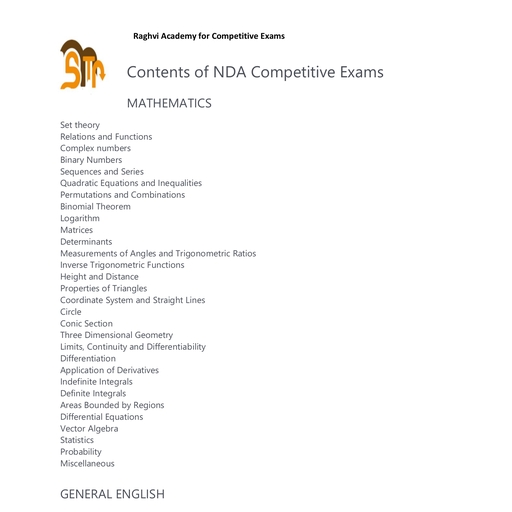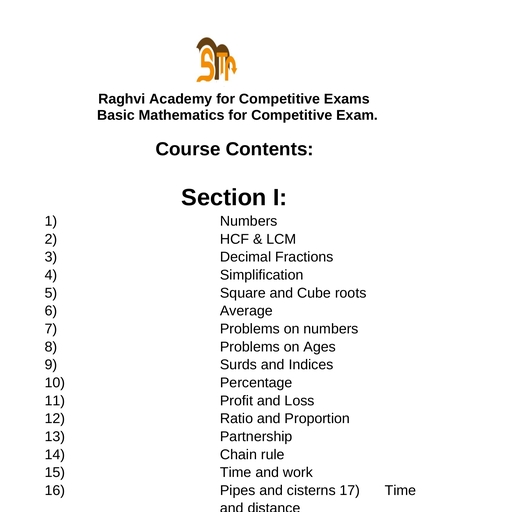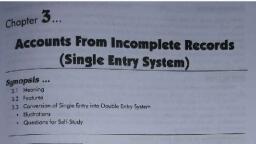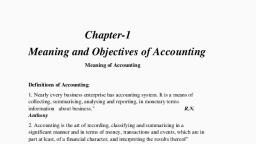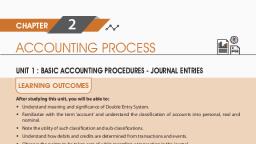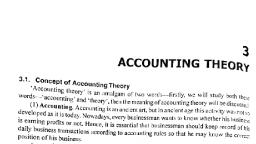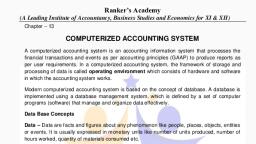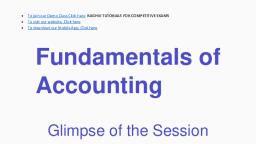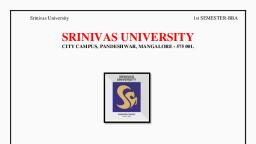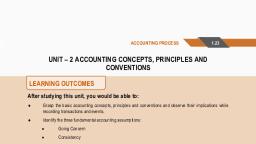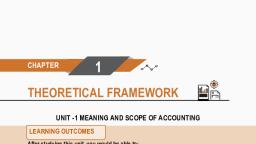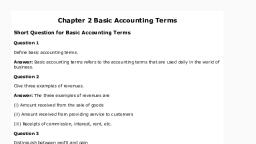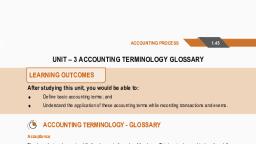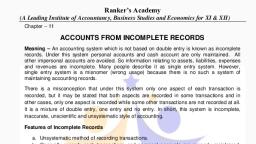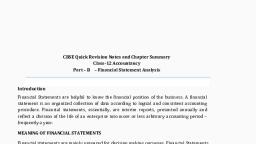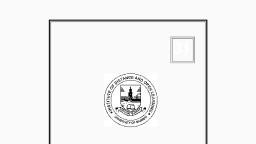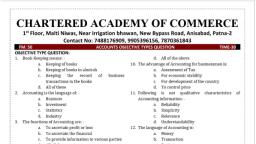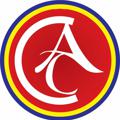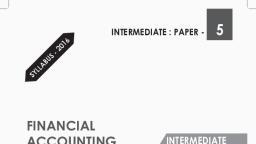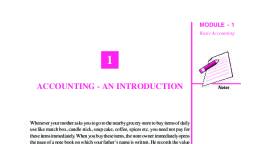Page 1 :
Chapter-1, Meaning and Objectives of Accounting, Meaning of Accounting, , Definitions of Accounting:, 1. Nearly every business enterprise has accounting system. It is a means of, collecting, summarising, analysing and reporting, in monetary terms, information about business.", R.N., Anthony, 2. Accounting is the art of recording, classifying and summarising in a, significant manner and in terms of money, transactions and events, which are in, part at least, of a financial character, and interpreting the results thereof", -American Institute of Certified Public Accountants, Characteristics of Accounting- An analysis of the above definitions brings out, the following as characteristics or features or attributes of accounting:, (1) Accounting is an Art as well as Science:-Art is the technique of attaining, some pre-determined objectives. Accounting is an art of recording, classifying, and summarizing business transactions with a view to ascertain the net profit, and financial position of the business enterprise., Any organised body of knowledge which is based on certain specified, principles is called science. In this respect accounting is also a science since it is, also an organised body of knowledge based on certain specified principles and, accounting standards., , (2) Recording of Financial Transactions only:- Only those transactions and, events are recorded in accounting which are of financial character. There are so, many transactions in the business which are very important for business but, which cannot be measured and expressed in terms of money and hence such, transactions will not be recorded., (3) Recording in terms of money:--- Each transaction is recorded in the books, in terms of money only. For example, if a businessman purchases 200 Chairs, and 10 Tables, their value in terms of money will be recorded in the books.
Page 2 :
In a small business where the number of transactions is quite small, all, transactions are first of all recorded in a book called Journal. But in a big, business where the number of transactions is quite large, the Journal is further, sub-divided into various subsidiary books such as, (I), ‘Cash Book' for recording cash transactions:, (II) Purchases Book' for recording credit purchases of goods, (III) Sales Book' for recording credit sales of goods:, (IV) Purchases Return Book for recording the return, (V) Sales Return Book' for recording the return of credit sales, (VI) Bills Receivable Book, (VII) Bills Payable Book, (VIII) Journal Proper etc. The number of subsidiary books to be maintained, depends on the size and nature of the business, (4) Classifying:- After recording the transactions in journal or subsidiary books,, the transactions are classified. Classification is the process of grouping the, transactions of one nature at one place, in a separate account. The book in which, various accounts are opened is called "Ledger name of each person, whether, customer or supplier. Likewise, separate accounts are opened for purchases,, sales, assets etc. Similarly, all expenses and incomes, which are already, recorded in Journal are again classified under separate heads in the Ledger, such, as Wages Account, Salary Account, Advertisement Account, Commission, Separate accounts are opened in the Ledger in the Account etc., (5) Summarising:- Summarising is the art of presenting the classified data in a, manner which is understandable and useful to management and other users of, such data. This involves the balancing of ledger accounts and the preparation of, Trial Balance with the help of such balances. Final Accounts are prepared with, the help of Trial Balance which include Trading and Profit & Loss Account and, a Balance Sheet. Trading account is prepared for calculating gross profit or, gross loss during the year. Profit and Loss Account is prepared to ascertain the, net profit or net loss during the year. Balance Sheet is prepared to present the, financial position of the business., Recording. Classifying and Summarising are also termed as 'Process of, Accounting’ or ‘Accounting Cycle’
Page 3 :
Transaction, Books of Original Entry, , Trading, Profit &, loss A/c and Balance, Sheet, , 1. Cash Book, , Journal, , 2. Purchase Book, 3. Sales Book, 4. Purchase Return Book, 5. Sales Return Book, 6. Bills Receivable Book, , Trial Balance, , Ledger, , 7. Bills Payable Book, 8. Journal Proper, , The above diagram shows the accounting cycle. This accounting cycle starts, with the recording of business transactions in the Journal or Subsidiary Books, and after passing through the Ledger and Trial Balance it results in the, preparation of Final Accounts (Le, Trading and Profit & Loss Account and, Balance Sheet). This accounting cycle is generally completed in an accounting, year and is again repeated in each subsequent year., (6) Interpretation of the results -In Accounting, the results of the business are, preserved in such a manner (he, by preparing trading and Profit & Loss Account, and Balance Sheet) that the parties interested in the business such as proprietors,, managers, banks, creditors, employees etc. can bus full information about the, profitability and the financial position of the business,, (7) Communicating:- Accounting attributes also include the communication of, financial data to the users who analyse them as per their individual, requirements., Objectives of Accounting, The following are the main objectives or utility of accounting:, (1) To keep systematic record of business transactions: The main objective, of accounting is to keep complete record of business transactions according, specified rules. Complete record of business transactions helps to avoid the
Page 4 :
possibility of omission and fraud. For this purpose, all the business transactions, are first of all recorded in Journal or Subsidiary Books and then posted into, Ledger., (2) To calculate profit or loss: The second main objective of accounting is to, ascertain the net profit earned or loss suffered on account of business, transactions during a particular period. For this purpose Trading and Profit &, Loss Account of the business is prepared at the end of each accounting period., All the items relating to purchases, sales, expenses and revenues (incomes) of, the business are recorded in Trading and Profit & Loss Account. If the amount, of revenue exceeds the expenditure incurred in earning that revenue, there is, said to be a profit. In case the expenditure exceeds the revenue, there is said to, be a loss. In addition, a businessman is able to get the following informations by, preparing a Trading and Profit & Loss AccountI. How much goods have been purchased during a particular period?, II. How much goods have been sold during a particular period?, III. How much goods have remained unsold and what is its value?, IV. How much amount has been spent on various heads of expenditure and how, much amount has been earned by various heads of revenues?, By attaining these information a businessman can keep effective control on, expenditure., (3) To know the exact reasons leading to net profit or net loss., (4) To ascertain the financial position of the business - For a businessman, merely ascertaining profit or loss of the business is not sufficient. The business, must also know the financial health of the business. For this purpose, after, prepar the Profit & Loss Account a statement called 'Balance Sheet' is prepared, whic the assets and their values on the one hand and the liabilities and capital on, the ouk hand. A Balance Sheet is actually a screen picture of the financial, position business. At one glance, one would know the following by looking at, the Blade Sheet, (i) How much the business has to recover from Debtors?, (ii) How much the business has to pay to Creditors?, (iii), How much the business has in the form of, (a) Cash in hand,, (b) Cash at Bank,, (c) Closing Stock, and, (d) Fixed Assets?
Page 5 :
(5) To ascertain the progress of the business from year to year., (6) To prevent and detect errors and frauds., (7) To provide information’s to various parties :- Another main objective of, accounting is to communicate the accounting information to various interested, parties like owners, investors, creditors, banks, employees and government, authorities etc. The information helps them in taking sound and judicious, decisions about the business entity, , Book-keeping, Accounting and Accountancy- These three are sometimes, considered as synonymous, i.e., having the same meaning. However, there is a, fundamental difference amongst book-keeping, accounting and accountancy., , "Book-Keeping is an art of recording business dealings in a set of books.", J.R. Batliboi, Book keeping is an art of recording in books of accounts the monetary aspect of, commercial or financial transactions.", - Northcott, , Accounting starts where book-keeping ends. It includes the following activities:, (i) Summarising the classified transactions in the form of Profit & Loss, Account and Balance Sheet etc., (ii) Analysing and interpreting the summarised results. In other words,, drawing the meaningful information from Profit & Loss Account and, Balance Sheet etc., (iii)Communicating the information to the interested parties., , Accountancy-It refers to a systematic knowledge of accounting concerned with, the principles and techniques which are applied in accounting. It tells us how to, prepare the books of accounts, how to summarize the accounting information, and how to communicate it to the interested parties. According to Kohler,, 'accountancy refers to the entire body of the theory and practice of accounting.’, OBJECTIVES OF BOOK-KEEPING
Page 6 :
1- Complete Recording of Transactions - It is concerned with complete, , and permanent record of all transactions in a systematic and logical, manner to show its financial effect on the business., 2- Ascertainment of Financial Effect on the Business - It is concerned with, the combined effect of all the transactions made during the accounting, period upon the financial position of the business as a whole., 3- DISTINCTION BETWEEN BOOK-KEEPING AND, , ACCOUNTING, S.No., 1., , Basis of, Distinction, Scope, , 2., , Stage, , 3., , Objective, , 4., , Nature of Job, , Book-keeping, Book-Keeping includes, (a) Identifying the, transactions of, financial nature, (b) Measuring the, identifying in terms, of money., (c) Recording the, measured transaction, (d) Classifying them into, ledger, , Accounting, , Accounting in, addition to BookKeeping includes, (a) Summarizing the, classified, transitions., (b) Analyzing and, interpreting the, summarized, result., (c) Communication, the results to, parties interested, in them., Book-Keeping is primary It is the secondary, Stage, stage. Accounting, starts where BookKeeping ends., The main objective of, Its main objective is, Book-Keeping is to, to ascertain the net, maintain systematic, results and financial, records of transaction of, position of the, financial nature, business and to, communicate them to, interested parties., The Book-keeping, The accounting, function is routine and, function is analytical, clerical in nature., in nature.
Page 7 :
5., , Who Performs, , 6., , Knowledge Level, , 8., , Analytical Skill, , The Book-Keeping, function performed by, junior staff, It can be performed by, persons having limited, level of knowledge., , The Accounting, function is performed, by senior staff., It is performed by, person having higher, level of knowledge, than that of BookKeeper., The Book-keeping is not, The Account is, required to possess, required to possess, analytical skill, analytical skill., , Qualitative Characteristics (Attributes) of Accounting Information, (1) Reliability -Accounting information must be reliable. Reliability implies, that the information must be factual and verifiable. The accounting, information is said to have verifiability if such information can be, verified from source documents such as cash memo, purchase invoices,, sales invoices, correspondence, agreement, property deed and other, similar documents. Verifiability ensures the truthfulness of the recorded, transactions which can be independently checked by anyone interested to, ascertain the true position. But if the source documents are not available,, the accounting information disclosed by profit and loss account and, balance sheet will not be capable of being verified and it would imply, that it cannot be relied on., (2) Relevance - Accounting information is depicted by financial statements, must be relevant to the objectives of the enterprise. Unnecessary and, irrelevant information should not be included in financial statements. To, be relevant, information must be capable of making difference in, decision, that is, it must help the management investors, creditors and, other users of the accounting information in making decisions., (3) Understandability - Accounting information should be presented in such, a simple and logical manner that they are understood easily by their users, such as investors, lenders, employees etc. A person who does not have, any knowledge of accounting terminology should also be able to, understand them without much difficulty. This can be done by giving, relevant explanatory notes to explain the information given in financial, statements. General topics which should be included in explanatory notes, are method of depreciation method of valuation of inventory, description
Page 8 :
of contingent liabilities, explanation of reserves, comment om, extraordinary gains and losses, disclosure of events occurring after the, balance sheet date etc. These explanatory notes make the financial, statements more useful and understandable., (4) Comparability- Comparability is a very useful quality of the accounting, information. The financial statements should contain the figures of, previous year along with the figures of current year so that the current, performance can be compared with past performance. Similarly, the, financial statements should be prepared in such a way that the, profitability and financial position of the concern may be compared with, other concerns of the similar type. Comparison reveals the strong and, weak points of the business entity. Comparability is possible when, different firms in the same industry adopt the same accounting principles, from year to year. For example, if diminishing balance method of, charging depreciation is selected, it should not be changed from year to, year., (5) Faithful Presentation – Financial statement are required to show a True, and fair view of the profitability, financial position and cash flows of an, enterprise. Application of appropriate accounting standards normally, results in financial statements portraying true and fair view of, information about an enterprise., In addition to the above, accounting information should also have the, characteristics of timeliness, neutrality and completeness.














